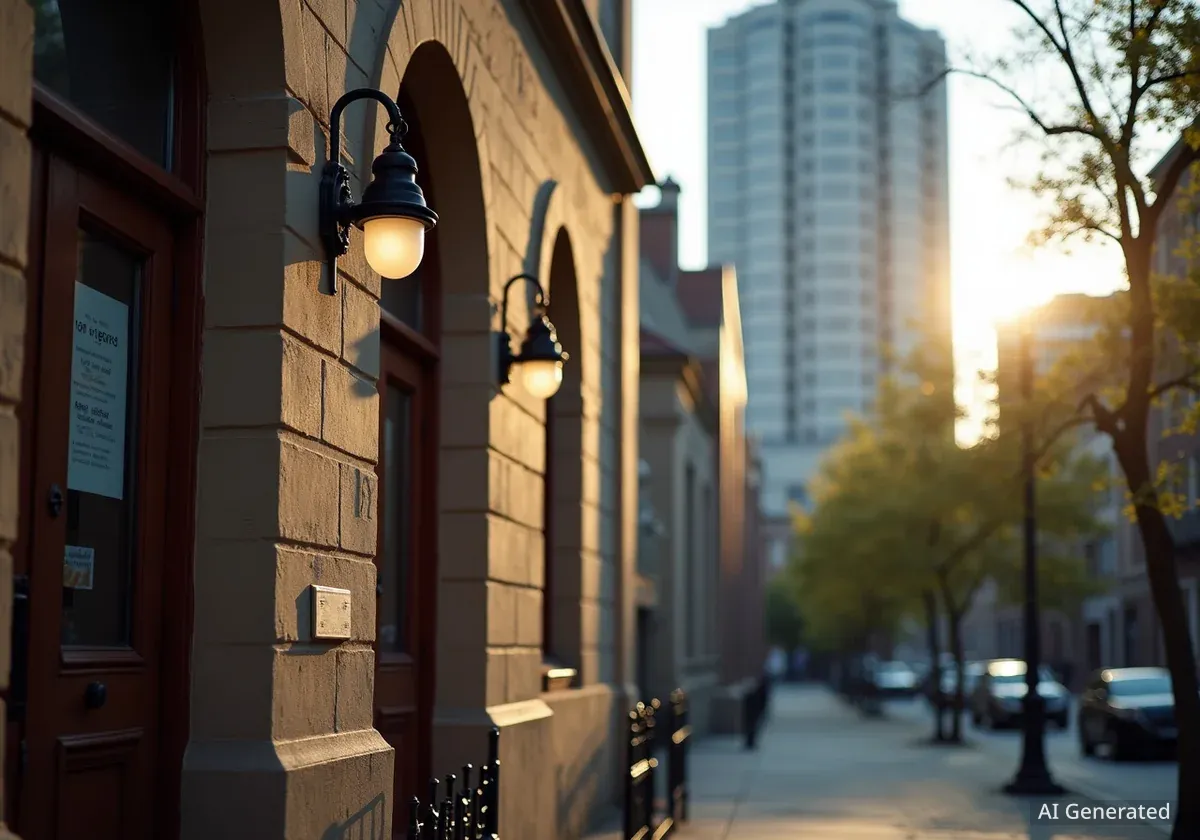Smaller synagogues in New York City are facing a significant challenge from the city's expensive real estate market. Unable to afford their own buildings, many congregations are forming creative partnerships with larger community organizations to secure places for worship.
These arrangements, born from necessity, are creating new models of community collaboration, though they also present unique challenges regarding stability and long-term security.
Key Takeaways
- High real estate prices in New York City make it nearly impossible for smaller synagogues to buy or rent dedicated properties.
- Congregations are increasingly renting space from larger institutions, including Jewish Community Centers (JCCs), schools, and even storefronts.
- These partnerships provide financial benefits to both the host and the smaller congregation but can be unstable if the host organization closes or goes bankrupt.
- Leaders in the community suggest that shared spaces strengthen Jewish organizations and propose creating funds to incentivize such collaborations.
The Challenge of Finding a Home
For small religious groups in New York City, finding a suitable and affordable space is a difficult task. Standard real estate websites don't list properties equipped for regular worship services, which have specific needs like rooms for services, community meals, and availability on key religious holidays.
Rabbi Adam Mintz, who leads a Modern Orthodox congregation, described the difficulty of this search. His group, Kehilat Rayim Ahuvim, needed a space on the Upper West Side for its 50 to 80 members. They could not afford the tens of millions of dollars required to purchase and develop a building.
"You can’t go on StreetEasy and find a synagogue space exactly as you want it," Rabbi Mintz stated, highlighting the unique requirements of a religious congregation.
After a long search, his congregation found a home within the National Council of Jewish Women’s building, where they remained for 21 years. Mintz called the arrangement a "win-win," as it provided his group with a below-market-rate space and gave the NCJW a steady income stream.
A Modern Problem in a Historic City
The struggle for physical space is a relatively recent phenomenon for many of the city's religious groups. David Kaufman, author of “Shul with a Pool” and an expert on the history of American synagogues, explained that the situation has changed dramatically in the 21st century.
"As real estate prices have gone sky high, New York City — and especially Manhattan — congregations have had to get creative," Kaufman said. He noted that in the 1970s and 1980s, renting was not as difficult. "Nowadays it’s nearly impossible," he added.
Historical Phases of NYC Synagogues
According to historian David Kaufman, the history of New York City's synagogues can be divided into four phases. The latest phase, beginning around the year 2000, is defined by the significant challenge of securing physical space as real estate values have soared to unprecedented levels.
This economic pressure has forced many congregations to adapt. For example, Kehillat Harlem rents a storefront property, while the Prospect Heights Shul operates out of Luria Academy, a Jewish school in Brooklyn. These solutions allow them to serve their communities without the immense financial burden of property ownership.
The Instability of Rented Spaces
While renting offers a lifeline, it does not guarantee permanence. Several congregations have found themselves suddenly without a home when their host organizations faced their own difficulties.
The independent minyan Darkhei Noam had been renting space from the Manhattan Country School since 2017 with a lease set to expire in 2034. However, when the school declared bankruptcy, the congregation was forced to find a new location quickly.
Similarly, the Fort Tryon Jewish Center is losing its space at the Fort Washington Collegiate Church in Upper Manhattan because the church is closing. This left the congregation searching for a new home before the end of the year.
The Search for Stability
After being displaced by their landlord's bankruptcy, Darkhei Noam secured a new, temporary home. The congregation signed a one-year lease with the Trevor Day School, highlighting the ongoing search for long-term stability that many smaller religious groups face.
Paul Wachtel, former co-chair of Darkhei Noam’s board, emphasized the core issue. "We need a space for all the Jewish occasions and events, but it would be impossible to buy and difficult to rent unless we have a partner who would make use of it at other times during the week," he said.
A New Model of Community Partnership
After two decades at the NCJW building, Rabbi Mintz's congregation recently moved into a new space, pioneering what he believes could be an ideal model for the future. His group, now rebranded as the Shtiebel @JCC, holds its services at the Marlene Meyerson JCC Manhattan.
Mintz is enthusiastic about the move, noting that his congregation is now located in "probably the busiest Jewish building in Manhattan." The partnership has already attracted new members to their services and given them access to the JCC's facilities, such as a rooftop sukkah for holiday celebrations.
Benefits Beyond Rent
This model of a smaller Jewish organization renting from a larger one offers more than just a physical space. It fosters a deeper sense of community and collaboration.
- Shared Mission: Partnering with a "mission-aligned" nonprofit can simplify operations, particularly around security protocols, as noted by Dina Mann, executive director of Temple Emanu-El’s downtown campus, which moved into the Center for Jewish History.
- Educational Opportunities: Mann added that being in the Center for Jewish History exposes their religious school students to different aspects of Jewish history.
- Joint Funding: Rabbi Jonathan Leener of Prospect Heights Shul said his synagogue's partnership with Luria Academy has enabled them to apply for grants together. "We’re hoping that some of the larger foundations and philanthropists are attracted by this model of Jewish community, of working together," he said.
Rabbi Mintz believes this collaborative approach should be adopted more widely. He suggests that large synagogues with underutilized space could prioritize renting to smaller Jewish nonprofits to strengthen the community from within.
Looking to the Future
Despite the success of these partnerships, challenges remain. The model is not universally applicable. For instance, the Fort Tryon Jewish Center serves Washington Heights, a neighborhood that lacks large Jewish institutions that could serve as hosts.
To encourage more of these collaborations, Rabbi Mintz has proposed the creation of a dedicated fund. Such a fund would provide financial incentives to both the host organization and the renting congregation, making the partnerships more sustainable for everyone involved.
"It’s such an important real estate model, and we don’t utilize our real estate properly," Mintz said. As property values continue to climb, these innovative partnerships may be the key to survival for many of New York City's smaller faith communities.





